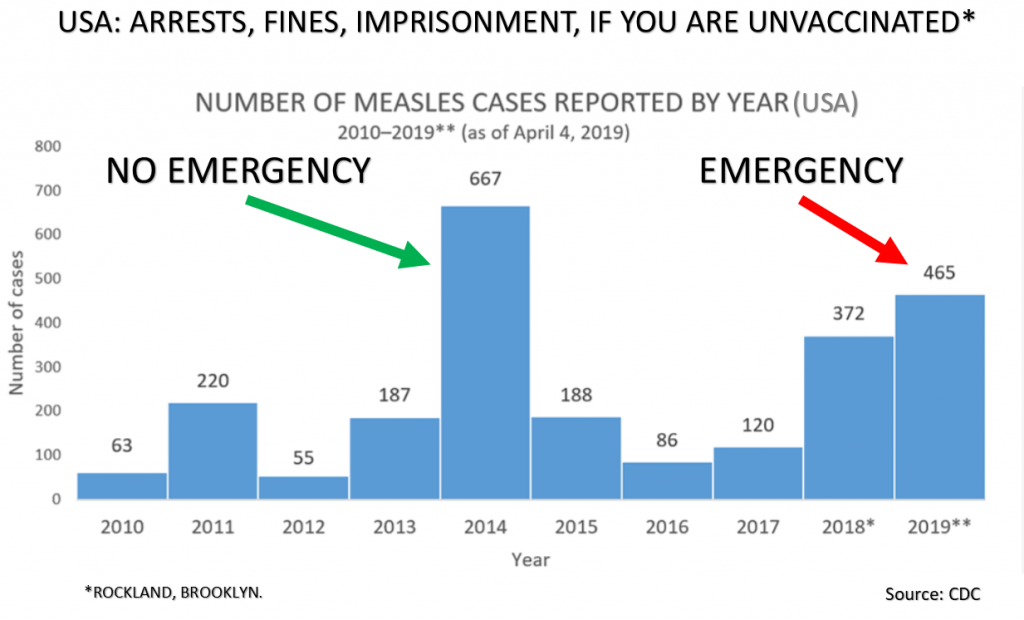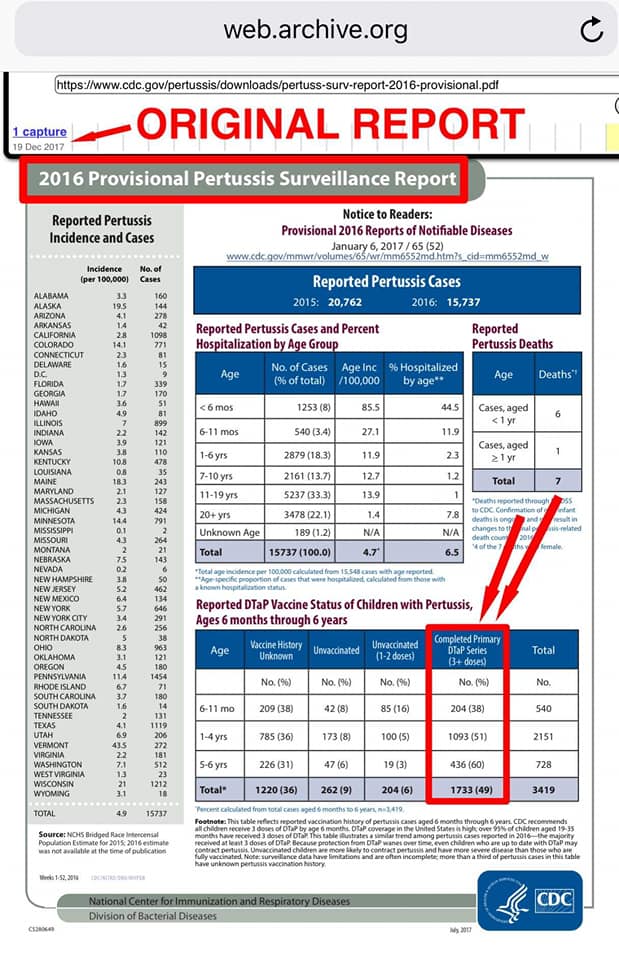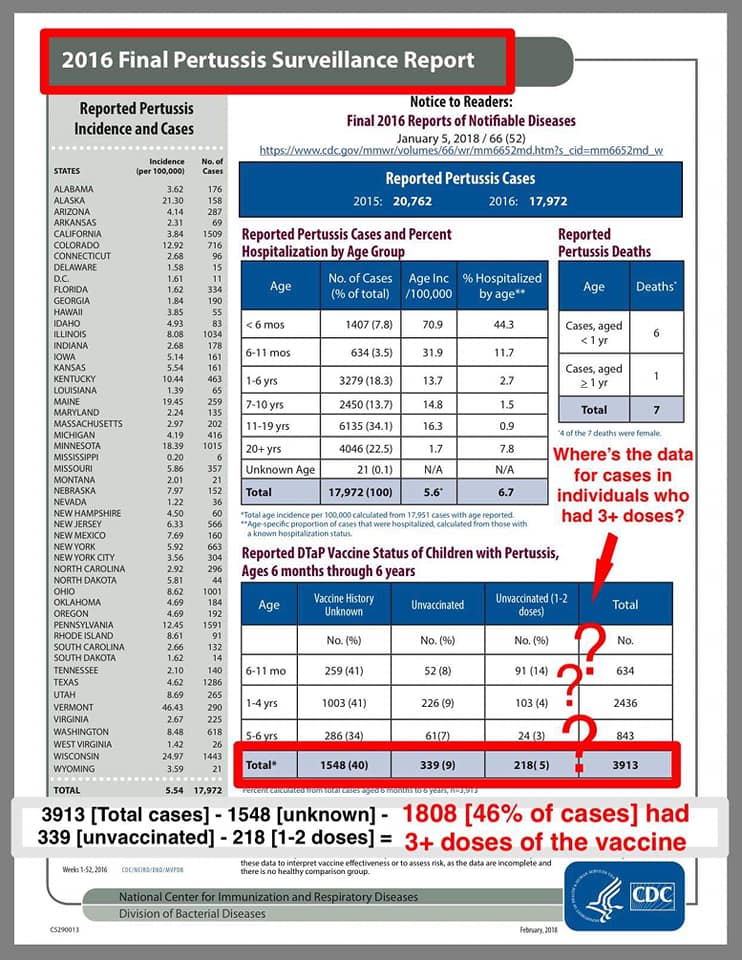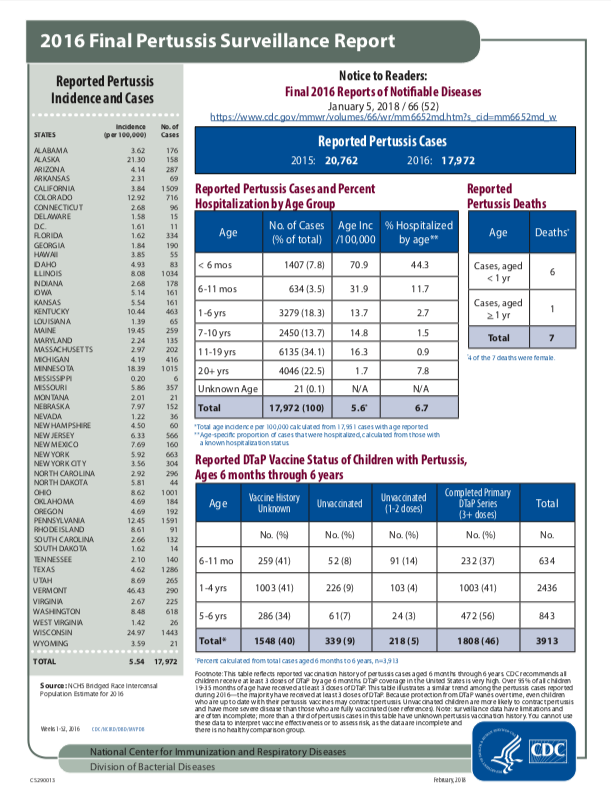
While New York City Mayor Bill de Blasio declared a public health emergency and ordered mandatory vaccinations, statistics show that higher rates of vaccination do not prevent outbreaks.
by Christina England
Health Impact News
As mass hysteria regarding the so-called ‘measles epidemic’ appears to be breaking out around the world, we need to ask ourselves whether or not this perceived epidemic is as bad as the corporate mainstream media has painted it. If it is, then are the vaccinations manufactured to protect our children against the measles and other illnesses really working?
Measles is on the Rise World-wide Despite Vaccine Mandates
During our research, we discovered that, despite many countries around the world mandating vaccines, there has been a substantial rise in the numbers of ‘vaccine preventable’ diseases being reported.
In February 2019, Science Direct published a paper titled Measles outbreaks in Italy: A paradigm of the re-emergence of vaccine-preventable diseases in developed countries.
The paper, written by Alessandro Siani, outlined the fact that, in 2017, there had been a significant rise in numbers of measles cases, in both Romania and Italy, two countries where the MMR vaccine had been mandated.
Siani stated:
“Measles has been identified as a powerful indicator of the status of vaccination programs in a region, as outbreaks have been reported to quickly emerge as a result of underlying problems in the immunisation routine.
This paper aims to report and critically comment on the factors underpinning the recent measles outbreaks in Italy, considering the psychological, cultural, social and political causes of vaccine hesitancy and refusal amongst the population.”
According to Siani, measles was on the rise because of vaccine hesitancy, and people refusing the vaccine; however, Siani appeared to forget that due to the mandates, more people had been vaccinated than ever before.
Even more interesting, his statistics appeared to be in line with those reported by the European Centre for Disease Prevention and Control (ECDC) in 2018.
Their report, titled Epidemiological update: Measles – monitoring European outbreaks, 8 September 2018, stated:
“In 2017, as of 5 September, Italy reported 4444 cases, including three deaths. Of these cases, 294 are healthcare workers. The median age is 27 years; 88% of the cases were not vaccinated, and 7% received only one dose of vaccine. In 2016, Italy reported 861 cases.”
We found this report particularly interesting because, in 2016, before Italy had mandated the MMR vaccine, Italian officials reported that there had been a total of 861 cases of measles. However, in 2017, after the Italian government had decided to mandate the vaccination, cases of measles rose substantially.
As expected, the ECDC reported that the majority of these cases occurred in the unvaccinated population; however, we found little evidence to substantiate these claims. According to our research, it appears that no matter how they try to ‘sugar coat’ the statistics, the figures just keep rising.
Furthermore, a second report, also published by the ECDC in 2019, stated:
Measles in January 2019
Twenty-nine countries reported measles data for January 2019, with 881 cases reported by 19 countries and 10 countries reporting no cases. Germany did not report measles data for January 2019 (Figure 1).
Overall, case numbers continued to increase compared with the previous two months. Romania, Italy, Poland and France had the highest case counts with 261, 165, 133 and 124 cases, respectively (Table 1).
Notable increases were reported in Italy, Poland, France and Austria.
• Italy reported 165 cases in January, compared with 76 in December and 58 in November.
• Poland reported 133 cases in January, compared with 114 in December and 79 in November.
• France reported 124 cases in January, compared with 54 in December and 61 in November.
• Austria reported 25 cases in January, compared with one in December and four in November. [Emphasis added]
Interestingly, the MMR had been mandated in all of the countries outlined above, except Austria, where the vaccination is highly recommended but not mandated.
As the Austrian statistics for measles are substantially lower than those for other countries outlined in the report, are children in countries with mandated vaccinations more likely to develop the diseases that they have been vaccinated against?
The ECDC continued:
Measles between February 2018 and January 2019
Between 1 February 2018 and 31 January 2019, 30 EU/EEA Member States reported 12 266 cases of measles, 8 580 (70%) of which were laboratory-confirmed. One country reported no cases. The highest number of cases were reported by France (2 800), Italy (2 632), Greece (1 862), Romania (1 247), United Kingdom (941), Slovakia (614) and Germany (516), accounting for 23%, 22%, 15%, 10%, 8%, 5% and 4% of all cases, respectively (Table 1). Notification rates per million population above the EU/EEA average (23.7) were reported by Greece (172.9), Slovakia (113.0), Romania (63.5), Italy (43.4) and France (41.8) (Figure 2).
The number of measles cases reported to TESSy may be an underestimation in certain cases. In particular, this may apply to Romania. The sustained outbreak in the country has caused delays in case-based reporting to TESSy and the most up-to-date data are available from the Romanian National Institute of Public Health. [Emphasis added]
In fact, according to the ECDC Measles Vaccination Schedule for Europe, the two countries that reported the highest statistics for measles, France and Italy, were both countries that had chosen to mandate the MMR vaccine.
When you compare the statistics for Italy and France with statistics from countries where the MMR is highly recommended but not mandatory, such as the UK, Austria and Germany, cases of measles are substantially lower in the countries without mandates.
We found these facts to be really worrying, especially as the World Health Organization (WHO) had stated the following, in a section headed Measles in Europe: record number of both sick and immunized:
“More children in the WHO European Region are being vaccinated against measles than ever before…”
Given these statistics, we need to ask some serious questions about public mandatory vaccination policies.
CDC Statistics Suggest Similar Findings
Interestingly, measles is also on the rise in the U.S., despite the mandates and the fact that U.S. citizens are currently being threatened with arrest, fines and imprisonment if they refuse to have the MMR vaccine.
According to the Centers for Disease Control and Prevention (CDC), there have so far been more cases of measles this year than there were in 2018. In fact, according to CDC’s figures, this year’s statistics are fast approaching those reported in 2014, when there was no emergency declared.
If these figures continue to rise, as they have over the past four months, this year’s statistics will be the highest since the year 2000.
The CDC stated:
“From January 1 to April 4, 2019, 465** individual cases of measles have been confirmed in 19 states. This is the second-greatest number of cases reported in the U.S. since measles was eliminated in 2000.” [Emphasis added]
On March 28, 2019, The Inquirer published a very balanced opinion-based article titled Stop telling anti-vaxxers they’re insane for questioning vaccines | Opinion. Author Bernice Hausman wrote:
“Last year was a big one for measles in the United States. This year is setting up to be even bigger, according to the Centers for Disease Control and Prevention.
We’ve already seen notable outbreaks nationwide, including in New York City, Washington state, and New York’s Rockland County, which on Tuesday declared an emergency blocking children and teenagers not vaccinated against measles from public places.” [Emphasis added]
Hausman stated:
“Indeed, every year since 2000, when measles was declared eliminated in the U.S., a traveler has brought measles from elsewhere.
News reports and editorials that mention the elimination of measles make it sound as if we had reached zero cases, but now, these reports suggest, because of dangerous anti-vaxxer parents, we have hundreds.”
She continued:
“But that’s not true. There have always been some cases in this country. Pretending otherwise provides grounds for unfairly vilifying non-vaccinating parents.”
She does have a point, because even in the year that the CDC declared that they had eliminated measles in the U.S., according to their own records, there were a total of 86 cases of measles in the U.S. that had been reported.
This being the case, we need to ask ourselves whether or not the measles virus was ever truly eliminated in the first place.
The CDC Covers up the Truth by Blaming Travelers
As expected, the CDC tried to cover up their apparent contradiction by blaming the 86 cases on travelers importing the virus from abroad. They stated:
“Of the 86 reported measles cases, 26 (30%) were inter-nationally imported*. Of the 60 indigenous cases, 18 were import-linked, nine were imported virus, and 33 were of unknown source. Importation-associated cases (i.e., imported, import-linked, and imported virus cases) accounted for 62% of all reported cases.”
In other words, instead of admitting that measles was never eliminated in the first place, the CDC blamed the 86 cases that were reported onto travelers who were traveling into the US from other countries.
“Every year, unvaccinated travelers (Americans or foreign visitors) get measles while they are in other countries and bring measles into the United States. They can spread measles to other people who are not protected against measles, which sometimes leads to outbreaks. This can occur in communities with unvaccinated people.”
We believe that even if the U.S. did achieve their goal of vaccinating 95% of all U.S. citizens with the MMR vaccine, measles would still exist due to vaccine failure.
Vaccine failure occurs when the vaccine fails to protect a person against the disease that they have been vaccinated for.
This can happen in one of two ways:
• Primary vaccine failure: This occurs when a person fails to produce antibodies (at detectable levels) or does not produce enough antibodies considered necessary to protect from the disease.
• Secondary vaccine failure: This occurs when a person does produce antibodies in response to vaccination, but the levels wane and decline at a faster rate than normally expected. However, antibodies to almost all vaccines decline over time, even after booster shots, so secondary vaccine failure in outbreaks of disease amongst the vaccinated is frequent.
In other words, even when you have vaccinated a large proportion of the population, there is no guarantee that a person will not contract the disease that they have been vaccinated against.
The Japanese Take the Cautious Approach to Vaccination and Report Fewer Outbreaks
According to Dr. Douglas Tweet, Japanese officials have the right idea about vaccination. In a letter to the editor of the news group Today.com, he wrote:
“Let’s look at the Japanese model. In 1989, the Japanese government made the MMR vaccine mandatory, but they experienced a large number of serious adverse reactions, and in 1993 banned MMR. Instead, they adopted individual vaccines for measles and rubella, and excluded mumps. Further, they made them optional and recommended not giving them at the same time. We were living in Japan with our young children during those years.”
Tweet continued:
“This Japanese caution about vaccines has continued. In 2013, Japan suspended the Merck Gardasil vaccine due to many adverse reactions in young women. Meanwhile, they have combined Measles and Rubella into a single vaccination, but still have kept Mumps separate. Many vaccines are optional in Japan. Their concern for child safety is paramount.
What has been the result of such a policy? Since 2015, Japan, a nation of 126 million people, has experienced annual numbers of measles cases ranging from 35 to several hundred. There has not been a catastrophic pandemic in spite of maintaining a voluntary system, while carefully monitoring adverse reactions. And Japan still has one of the lowest rates of infant mortality in the world, far lower than the US with its more aggressive vaccine schedule.” [Emphasis added]
Fully Vaccinated Children Still Get and Spread Measles
We believe that Dr. Tweet is correct, because there is evidence to suggest that fully vaccinated children can still go on to develop measles and other illnesses that they have been vaccinated against.
In a paper tiled The Re-Emergence of Measles in Developed Countries: Time to Develop the Next-Generation Measles Vaccines? Dr. Gregory A. Poland, a researcher at the Mayo Clinic, explained that measles outbreaks can occur in even highly vaccinated populations. He wrote:
Receiving less attention, however, is the issue of vaccine failure. While the current vaccine is acknowledged as a good vaccine, we and others have demonstrated that the immune response to measles vaccine varies substantially in actual field use.
Multiple studies demonstrate that 2–10% of those immunized with two doses of measles vaccine fail to develop protective antibody levels, and that immunity can wane over time and result in infection (so-called secondary vaccine failure) when the individual is exposed to measles.
For example, during the 1989–1991 U.S. measles outbreaks 20–40% of the individuals affected had been previously immunized with one to two doses of vaccine.
In an October 2011 outbreak in Canada, over 50% of the 98 individuals had received two doses of measles vaccine. The Table shows that this phenomenon continues to play a role in measles outbreaks.
Thus, measles outbreaks also occur even among highly vaccinated populations because of primary and secondary vaccine failure, which results in gradually larger pools of susceptible persons and outbreaks once measles is introduced. This leads to a paradoxical situation whereby measles in highly immunized societies occurs primarily among those previously immunized.
Other studies have also shown that fully vaccinated individuals still can contact and spread measles. See:
Outbreak of Measles Among Persons With Prior Evidence of Immunity, New York City, 2011 – Clinical Infectious Diseases, Volume 58, Issue 9, 1 May 2014
Rapid Identification of Measles Virus Vaccine Genotype by Real-Time PCR – Journal of Clinical Microbiology Feb 2017
Kennedy Questions Why the Media Make No Mention of the Mumps Crisis
In his recent article, Robert F. Kennedy Jr. explained that while there appears to be an ongoing fear campaign surrounding measles, which has prompted a push for Merck’s MMR to be mandated across the U.S., it appears that no one is covering the ongoing mumps crisis.
He wrote:
“Although ongoing mumps outbreaks involving thousands of at-risk adolescents and young adults completely dwarf the number of measles cases, no one is covering the mumps story—because it will expose the fact that Merck has been in court for over eight years due to scientists blowing the whistle on Merck’s fabrication and falsification of the effectiveness of the mumps component of its MMR vaccine.”
In a shocking statement, Kennedy stated:
“Researchers confirm an increase in the median age of mumps patients, a surge in the size and number of mumps outbreaks in highly vaccinated populations and higher rates of complications—including orchitis.”
He continued:
“Across the country, galloping mumps epidemics have been ravishing an older generation of vaccinated individuals.
The Centers for Disease Control and Prevention (CDC) reported 150 outbreaks (9,200 cases) in the year and a half from January 2016 to June 2017, affecting “schools, universities, athletics teams and facilities, church groups, workplaces, and large parties and events.”
If he is correct, then the MMR vaccine is not only failing to protect individuals against measles, but it is also failing to protect individuals against mumps.
Total of 5563 Fully Vaccinated Children Develop Whooping Cough
As an example of vaccine failure, one only needs to look at all the current outbreaks of whooping cough happening among those fully vaccinated with the pertussis vaccine.
For years medical authorities and the corporate “mainstream” media blamed these whooping cough outbreaks on unvaccinated children, but now it is widely accepted that the pertussis vaccine is a failure, and needs to be replaced.
We were given a series of charts that had been originally published on the CDC website. The charts highlighted evidence showing that in 2012, 5563 fully vaccinated children had developed pertussis (whooping cough) after they had received 3 doses of the DTaP vaccine.
CDC Caught Omitting Data to Cover up the Truth
Similar statistics were outlined in the CDC’s provisional report for 2016, in which the CDC had reported that there was a total of 1733 cases of pertussis in the fully vaccinated. However, obviously concerned about their findings, the CDC decided to change the data that was published in their final report by completely omitting the column for the fully vaccinated.
In fact, we discovered that when you researched their data going back to 2012, the CDC had included the number of cases of pertussis in individuals who received 3+ doses of the pertussis vaccine (recognized as “fully vaccinated”) in all of their documentation – until 2016, when they chose to omit the data for the fully vaccinated altogether.
However, since these original screenshots were taken and reported, the CDC has decided to put the original documents back on their website. In doing this, the CDC has made yet another critical error: the figures for the fully vaccinated now state that in 2016, 1808 children developed whooping cough, after receiving 3 doses of the DTaP, instead of the original 1733.
We believe that this once again proves categorically that the CDC cannot be trusted to publish the truth about vaccinations. As we have previously reported, they have a conflict of interest due to the fact that they are the largest purchaser of vaccines, spending $5 billion annually to purchase vaccines. See:
Should the CDC Oversee Vaccine Safety When They Purchase Over $5 Billion of Vaccines from Big Pharma?
Conclusion: Vaccine Mandates do NOT Prevent Outbreaks
Looking back over the data we have provided, it is obvious that vaccination mandates are not working.
We have not even covered the issue of vaccine “shedding” with live attenuated vaccines here, or that mass vaccination campaigns might actually be contributing to these outbreaks, rather than preventing them.
Leaving a lucrative career as a nephrologist (kidney doctor), Dr. Suzanne Humphries is now free to actually help cure people.
In this autobiography she explains why good doctors are constrained within the current corrupt medical system from practicing real, ethical medicine.
One of the sane voices when it comes to examining the science behind modern-day vaccines, no pro-vaccine extremist doctors have ever dared to debate her in public.
-
Book – The Vaccine Court, by Wayne Rohde – 240 pages
“The Dark Truth of America’s Vaccine Injury Compensation Program”
FREE Shipping Available!
ORDER HERE!












4 Comments